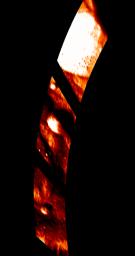
|
Tarpeia Temperature
- Click the image above for a larger view
- Full-Res JPEG (697 x 1322) (45.6 kB)
- Full-Res TIFF (697 x 1322) (2.8 MB)
Caption:
This colorized image from NASA's Dawn mission shows temperature variations at Tarpeia crater, near the south pole of the giant asteroid Vesta. It was obtained by the visible and infrared mapping spectrometer. The white areas are the warmest, measuring about minus 10 degrees Fahrenheit (minus 23 degrees Celsius). The dark areas are the coldest, with temperatures at or below minus 150 degrees Fahrenheit (minus 100 degrees Celsius), the bottom of the visible and infrared mapping spectrometer's range.
The variations in the red shading indicate the intensity of the emitted light in the 5-micron wavelength, which is indicative of the surface temperature.
The visible and infrared mapping spectrometer obtained the images during Dawn's low-altitude mapping orbit (130 miles or 210 kilometers in altitude) on Feb. 5, 2012.
Background Info:
The Dawn mission to Vesta and Ceres is managed by NASA's Jet Propulsion Laboratory, a division of the California Institute of Technology in Pasadena, for NASA's Science Mission Directorate, Washington. UCLA is responsible for overall Dawn mission science. The visible and infrared mapping spectrometer was provided by the Italian Space Agency and is managed by the Italy's National Institute for Astrophysics, Rome, in collaboration with Selex Galileo, where it was built.
More information about the Dawn mission is online at http://www.nasa.gov/dawn and http://dawn.jpl.nasa.gov .
Cataloging Keywords:
| Name | Value | Additional Values |
|---|---|---|
| Target | 4 Vesta | |
| System | Main Belt | |
| Target Type | Asteroid | |
| Mission | Dawn | |
| Instrument Host | Dawn | |
| Host Type | Orbiter | |
| Instrument | Visible and Infrared Spectrometer (VIR) | |
| Detector | ||
| Extra Keywords | Color, Crater, Infrared | |
| Acquisition Date | ||
| Release Date | 2012-04-25 | |
| Date in Caption | 2012-02-05 | |
| Image Credit | NASA/JPL-Caltech/UCLA/INAF | |
| Source | photojournal.jpl.nasa.gov/catalog/PIA15601 | |
| Identifier | PIA15601 | |
